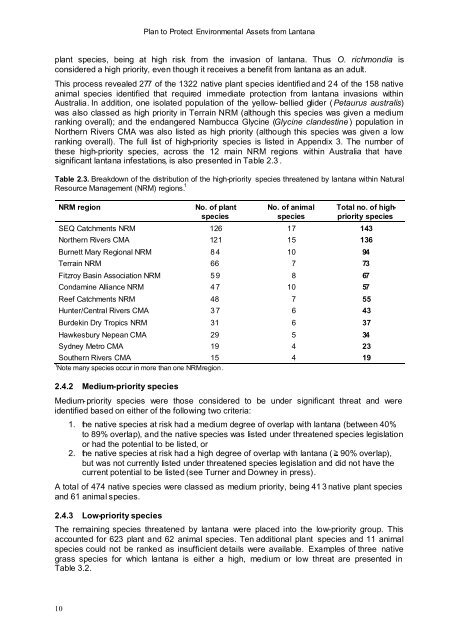Plan to Protect Environmental Assets from Lantana - Weeds Australia
Plan to Protect Environmental Assets from Lantana - Weeds Australia
Plan to Protect Environmental Assets from Lantana - Weeds Australia
You also want an ePaper? Increase the reach of your titles
YUMPU automatically turns print PDFs into web optimized ePapers that Google loves.
<strong>Plan</strong> <strong>to</strong> <strong>Protect</strong> <strong>Environmental</strong> <strong>Assets</strong> <strong>from</strong> <strong>Lantana</strong><br />
plant species, being at high risk <strong>from</strong> the invasion of lantana. Thus O. richmondia is<br />
considered a high priority, even though it receives a benefit <strong>from</strong> lantana as an adult.<br />
This process revealed 277 of the 1322 native plant species identified and 24 of the 158 native<br />
animal species identified that required immediate protection <strong>from</strong> lantana invasions within<br />
<strong>Australia</strong>. In addition, one isolated population of the yellow- bellied glider (Petaurus australis)<br />
was also classed as high priority in Terrain NRM (although this species was given a medium<br />
ranking overall); and the endangered Nambucca Glycine (Glycine clandestine ) population in<br />
Northern Rivers CMA was also listed as high priority (although this species was given a low<br />
ranking overall). The full list of high-priority species is listed in Appendix 3. The number of<br />
these high-priority species, across the 12 main NRM regions within <strong>Australia</strong> that have<br />
significant lantana infestations, is also presented in Table 2.3 .<br />
Table 2.3. Breakdown of the distribution of the high-priority species threatened by lantana within Natural<br />
Resource Management (NRM) regions. 1<br />
NRM region<br />
No. of plant<br />
species<br />
No. of animal<br />
species<br />
Total no. of highpriority<br />
species<br />
SEQ Catchments NRM 126 17 143<br />
Northern Rivers CMA 121 15 136<br />
Burnett Mary Regional NRM 8 4 10 94<br />
Terrain NRM 66 7 73<br />
Fitzroy Basin Association NRM 5 9 8 67<br />
Condamine Alliance NRM 4 7 10 57<br />
Reef Catchments NRM 48 7 55<br />
Hunter/Central Rivers CMA 3 7 6 43<br />
Burdekin Dry Tropics NRM 31 6 37<br />
Hawkesbury Nepean CMA 29 5 34<br />
Sydney Metro CMA 19 4 23<br />
Southern Rivers CMA 15 4 19<br />
1 Note many species occur in more than one NRMregion.<br />
2.4.2 Medium-priority species<br />
Medium-priority species were those considered <strong>to</strong> be under significant threat and were<br />
identified based on either of the following two criteria:<br />
1. the native species at risk had a medium degree of overlap with lantana (between 40%<br />
<strong>to</strong> 89% overlap), and the native species was listed under threatened species legislation<br />
or had the potential <strong>to</strong> be listed, or<br />
2. the native species at risk had a high degree of overlap with lantana ( 90% overlap),<br />
but was not currently listed under threatened species legislation and did not have the<br />
current potential <strong>to</strong> be listed (see Turner and Downey in press).<br />
A <strong>to</strong>tal of 474 native species were classed as medium priority, being 41 3 native plant species<br />
and 61 animal species.<br />
2.4.3 Low-priority species<br />
The remaining species threatened by lantana were placed in<strong>to</strong> the low-priority group. This<br />
accounted for 623 plant and 62 animal species. Ten additional plant species and 11 animal<br />
species could not be ranked as insufficient details were available. Examples of three native<br />
grass species for which lantana is either a high, medium or low threat are presented in<br />
Table 3.2.<br />
10

















